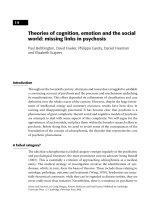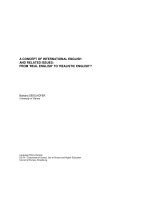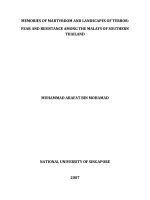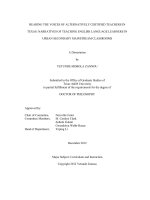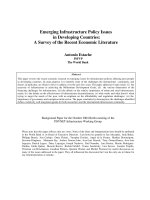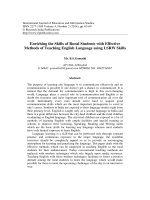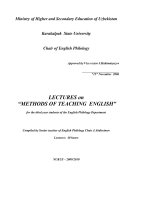Survey of Methods of Teaching English and Literature among Secondary School Teachers in Benue State
Bạn đang xem bản rút gọn của tài liệu. Xem và tải ngay bản đầy đủ của tài liệu tại đây (73.14 KB, 12 trang )
International J. Soc. Sci. & Education
2013 Vol.3 Issue 3, ISSN: 2223-4934 E and 2227-393X Print
Survey of Methods of Teaching English and Literature among
Secondary School Teachers in Benue State
By
Bola Adelabu and Nder Matthias
Department of Educational Foundations and General Studies,
University of Agriculture, Makurdi
Abstract
This survey study looks at the teachers’ level of awareness and utilization of teaching methods as applicable to the
teaching of English and Literature in English. The respondents of this study were one hundred and ten (110) English
and Literature in English teachers who participated in the re – training workshop organised for secondary school
teachers in Benue State. The data for the study were collected from the respondents through the structured
questionnaire which required the respondents to indicate their level of awareness and utilization of twenty (20)
different methods of teaching the two subjects. Analysis was done using simple percentage. The results of the study
indicated that not all the teachers were aware of all the methods. Majority knew and utilized the textbook, discussion
and demonstration methods. Most of them have neither heard nor used the field and laboratory methods. The
implication of the findings is that, the teaching and learning of the English Language and Literature in English would
be sub-standard and dull. The researchers therefore recommend among others that teachers should be exposed to
more training so as to be more knowledgeable about the various methods, make use of the appropriate ones and
combine different and suitable methods when necessary for better teaching and learning.
1. Introduction
The development of any country depends on the standard of education which also depends on the
teaching – learning process or method at the various levels of education especially at the secondary
school level. The secondary school education prepares students for tertiary education as well as training
the products to be self reliant should they desire not to further their education. Realizing this fact, the
Federal Government of Nigeria in National Policy of Education (2004) outlines, among other goals, that
the secondary school education shall inspire students with a desire for self improvement, achievement of
excellence, provide technical knowledge and vocational skills necessary for agricultural, commercial and
economic development. In order to achieve these, secondary school teachers must be innovative, creative
and strategic in their teaching. The Federal Government recognizes the importance of the teacher and
declares that, “no education can rise above the quality of its teachers.” The curriculum implementation at
the classroom level is basically the responsibility of the teacher. It is the teacher who translates the
objectives, concepts and topics in the curriculum into activities that are meaningful to the learner.
(Robinson, cited in Oyetunde, 2004).
The English and literature teachers are not exceptions. In fact they have to do more because of the
importance of English Language at the secondary school level, beyond and in the society. Students who
desire to gain admission into any tertiary institution, for instance, require a credit in English. A good
mastery of the English Language is also necessary if students must perform well academically and
communicate well in Nigeria. This is more so as the country has adopted English as her lingua franca.
If students at the secondary school level must gain mastery of the English language, they must be taught
well. If they must be taught well, teachers must make use of various methods to enhance their teaching.
The method or strategy employed by a teacher to generate or illuminate a task in the classroom situation
can either make or mar the learners’ academic performance. As Ukeje, Igwue and Wenghinsky (cited in
Ntekim 2009) declare, teachers’ classroom practice and instructional strategies used greatly influence
847
Survey of Methods of Teaching English and Literature among Secondary School Teachers in Benue State
students’ performance and more attention should be paid to improving classroom practices. Ntekim
(2009) is of the opinion that difference in performance of students is attributed to teacher’s method of
lesson presentation and that whenever an individual is determined to succeed and is properly guided using
effective strategy, the students more often than not perform excellently.
To Oyetunde (2004), besides the selection of the appropriate instructional strategy, effective teaching
calls for other critical considerations such as the teacher’s clear understanding of the subject matter and
his appreciation of what makes some topics or concepts difficult to students. The teacher’s understanding
of the status, background, knowledge, interests and experiences of the student is equally important. This
is in addition to his frequent evaluation of whether or not students have learnt (and to what degree) what
is being taught.
The English teacher remains a crucial element in education delivery, Ogunkunle and Mbaleke (2008) note
that no matter how well the curriculum is planned, it is useless if it is not implemented properly and the
teacher is at the centre of curriculum implementation. As the implementer of curriculum, the teacher
should ensure he uses various methods and strategies to implement and deliver his teaching for students
to benefit maximally. If teachers do not know about these methods, it would be difficult to vary their
methods of teaching, and this will make teaching and learning boring for both students and teachers.
It is natural with learners to be aware about things around them. Their interest and readiness to know
about things around them changes as they grow. They are always in search of facts and values of the
society they live in. Any type of teaching which takes into consideration the interest of learners will likely
succeed because the latter will show keen interest in learning. Applying various methods will certainly
arouse students’ interest. Some of these methods are highlighted below.
2. Some Methods of Teaching
The way or manner a teacher exposes his materials to learners for purposes of learning and the acquisition
of knowledge, information, ideas and skills is what is generally considered as teaching method. When
appropriately employed, the teaching method sufficiently engages the learner, reduces boredom,
stimulates the learner’s curiosity and interest and effective learning takes place.
A number of methods are available for the effective teaching of English Language and Literature in
English and indeed other subjects. These are not exclusive to the following: \
Lecture Method:
This is largely an oral delivery and teacher centered method. Information, knowledge, ideas and skills are
orally presented to the learner. Appropriate instructional materials are often used to complement oral
delivery. This method is suitable for large classes and when the teacher has only a few instructional
materials at his disposal.
For the method to be effective, the teacher ought to be fluent and simplistic in presentation. While the
lecture method may be seen as time saving and cost effective, it is most suitable for the advanced level
learner. One disadvantage of the method is that it encourages inactivity and the passivity of learners. Its
over reliance on the active engagement of the teacher and the learning ability of the learner makes it a less
preferred method.
Absence of sufficient feed-back information is another limitation of the method as a systematic way of
teaching.
Demonstration Method:
The method involves the use of objects, pictures, diagrams and other visual images. It is most appropriate
for learners (e.g. children) who appreciate visual images more than oral discourse. The use of visual
848
Bola Adelabu and Nder Matthias
images enhances concentration and recall. The demonstration method can be more effective when
complemented with oral discussion, and when the information or knowledge to be imparted ought to be
systematically presented in steps for easier comprehension.
The method, however, could be costly as it often requires the purchase of items to be demonstrated.
Besides, more time and greater skills may be required to set up and demonstrate items. Sometimes these
requirements may be lacking or inadequate. While the demonstration method may be most appropriate for
the physical sciences, its application value is less appreciated in Linguistics and Literature, for instance.
Problem solving Method:
Here, the method emphasizes and encourages critical thinking and creativity on the part of the learner.
Learners are usually provided with appropriate tasks or problems and required to find solutions to them
on their own. The instructor (teacher) merely guides the learner through on how the presented problem or
issue could be resolved.
Project method:
This is similar to the problem-solving method as it encourages the independent activity and effort of the
learner under the supervision of the teacher. However, unlike the problem-solving method, the learner
selects the materials himself, does the planning and logically executes the project. For the method to be
effectively used, and its objective realized, the teacher should avoid the temptation of doing aspects of the
work for the learner.
The method has the advantage of generating interest, curiosity and enforcing cooperation and solidarity
between the learner and the teacher. Group cooperation could equally be fostered among learners when
they work in groups. Besides, working in groups can provide learners the opportunity to discover their
leadership qualities and potentials.
Vee – Mapping:
Vee – mapping strategy helps students to understand how new knowledge is attained in an experimental
situation. It begins by focusing attention on what they know before enquiry. Thereafter they generate
research questions, design, conduct experiment and interpret data. Through interpretation of data, they
arrive at new knowledge that must be integrated with their prior knowledge.
Vee – mapping has two sides – a conceptual (knowing) one and methodological (doing) one that
interplay. What we know at any moment determines the question we ask, the way we find answers to the
question and the way we interpret data. On the other hand, what we do determines what we will know and
thus changes what we know before the experiment.
Vee – mapping can also be used to teach English and literature because it is a strategy that guides
students in their quest for new knowledge and help them to interpret what they discover. It is a road map
showing a route from prior knowledge to new and future knowledge. This roadmap, can be
conceptualized in terms of the general questions highlighted below
What do we want to find out? (focus question)
What do we currently know about it? (associated words)
How did we find answers to the former knowledge?(experiment)
What do our observations mean? (claims of knowledge)
How are our ideas about a topic related? (concept map)
Though the questions would be asked in sequential order, a vee – map identifies the complex relationship
between the various parts.
Vee – mapping generally helps a student to identify why he/she did what, how he/she did it, what he/she
concluded and how the inquiry affected his or her prior knowledge.
849
Survey of Methods of Teaching English and Literature among Secondary School Teachers in Benue State
Discussion Method:
This is an interactive method which involves the verbal exchange of views, opinions or ideas. The teacher
considers a topic or issue, and may raise it for discussion by the students. The view is vigorously argued,
resolutions arrived at and suggestions and conclusions drawn. This method is appropriate for polemical
topics in English and Literature in English lessons. Where applicable, efforts should be made by the
teacher to select familiar issues that iare within the interest and experience of the student.
The whole class or groups of students may be considered in the application of the method. Whichever
arrangement preferred, the teacher should moderate and direct the discussion for effective results. The
method helps to remove boredom and inculcate in students positive skills such as the ability to critically
think and analyze issues. It equally helps to improve the oral communication skills of students. However,
it can hardly be effectively used for large classes because of time and organizational constraints. The
discussion method could take forms such as debates, panel discussions, symposium and the lone-opposer
method.
The Play Method:
The play or dramatic method involves shared activities such as the acting or dramatization of the subject
matter. It employs the “make believe” medium and is most appropriate for subjects such as Literature in
English and other discursive fields. For instance, in Literature in English, learners may be called upon to
act or dramatize the scene, or setting of a story, idea or event.
When effectively employed, the play method stimulates interest, retention, understanding, recall and
comprehension in learners. Cooperation, team spirit and leadership skills could equally be developed in
learners through the play method as it utilizes both mental and social skills. Besides, active learning takes
place while the student enjoys the pleasures of the game. Major draw backs of the method include the so
much time it would take to act the drama, and the cost that may be required to procure costumes and other
materials for dramatization.
Individualized Instruction Method:
This method recognizes the fact that every learner is unique especially in terms of perception and ability.
Through the method, a student is made to learn, on his own, a topic or lesson according to his interest,
taste, ability and pace. The learning materials are thus specifically designed for the purpose and the
teacher merely serves as a consultant.
The method can hardly be effectively used in most Nigerian schools because of the high cost of materials
it requires. Besides, its effectiveness depends on some level of expertise by the teacher. This may be
lacking in most schools.
Discovery Method:
In this method, facts or knowledge are acquired by the students through the understanding of concepts.
There is a movement from knowledge of specific examples, to unfamiliar concepts, generalizations and
principles. The method can be appropriately used for the teaching of items, concepts and issues in both
English language and Literature in English. Students may be given lots of assignments and practices and
required to provide examples. The teacher would be expected to guide the students as they strive to get at
the correct answers. One advantage of the method is the promotion of activity study by students. It
equally helps to enforce comprehension and recall as the students remember longer what they themselves
have discovered. However, the method could be time consuming and expensive especially in the choice
of instructional materials.
Guided Discovery:
The method is based on the premise that learning is made easier when learners construct or invent their
understanding of the world; when learners construct their own knowledge from materials and
850
Bola Adelabu and Nder Matthias
hypothetical situations presented to them. This could be effectuated with maximum results when learners
are guided to manipulate objects, raise questions and controversies among other strategies.
For instance, for students to become effective readers, writers and communicators, they need to not only
cultivate the habit of extracting meanings and pieces of information from text, but should be capable of
using their previous knowledge to reason critically, and interrogatively.
The method has been found useful for the effective teaching and stimulation of discussions in literature in
English and the English language. Topics such as literary analysis and interpretation, comprehension and
summary writing can be effectively learnt through the guided discovery method.
The promotion of critical and independent thinking for the acquisition of ideas, information and
knowledge, through analysis, synthesis and evaluation is one advantage of the guided discovery method.
The procedure equally has the advantage of easy recall and the retention of ideas and information that has
been learnt.
Concept Mapping:
The thesis of this approach is that meaningful learning takes place through the cumulative experience of
learning by pilling up new ideas and information on previous knowledge. The learning process is
progressively sequenced into the acquisition of new facts, ideas and knowledge through the process.
Other ways through which learning could be aided include:
a.
The ability of the learner to establish similarities, differences and other forms of
relationships, between items and issues.
b.
When the learner understands that two or more ideas or concepts could, for instance,
enjoy a relationship of inclusion of exclusion.
c.
Learning can be made easier, comprehensible, recall and retention enhanced through
processes not exclusive to definitions, classifications, exemplifications and the
elaboration of ideas.
Topics in all the genres of Literature can be effectively taught and evaluated through the method. This is
also true of topics in the various aspects of English such as syntax, morphology, semantics, phonetics and
phonology.
Team Teaching:
The concept of team – teaching is based on the understanding that each teacher has an area of
specialization, preferences, content mastery and he could teach the specialized knowledge in some
classes. In this approach, teachers of the same area of specialization, for instance, could cooperate to plan,
teach and evaluate a teaching unit or activity.
Team teaching could take an integrative or an interdisciplinary coloration as in when teachers of various
subjects cooperatively come together to plan and teach a particular topic.
The method equally recognizes that besides interest and mastery of subject content, teachers have
comparative advantage in the areas of experience, exposition, stamina, resourcefulness, voice projection,
class management, etc
The potentials, skills and talents of many teachers could easily be made available to students through the
method. This is one advantage of the method. Besides, as opposed to the one – teacher, one – class
arrangement, team–teaching avails students the opportunity of getting the best from one location, the
expertise of several teachers.
851
Survey of Methods of Teaching English and Literature among Secondary School Teachers in Benue State
The knowledge of these methods will enable teachers to choose the appropriate ones, at the right time,
given the diversity of topics and concepts both in English and Literature in English. Teacher’s could
equally combine and or vary their methods. But how much of these methods do secondary school
teachers of English and Literature in English in Benue State know? The researchers decided to find out
those methods the teachers in Benue State were conversant with and those that they frequently used as
they teach English and Literature in English.
Research Questions:
Three research questions were raised to guide the study:
1.
What are the teaching methods know to teachers of English and literature?
2.
Which methods do teachers of English and Literature use?
3
Which methods are commonly and rarely used by the teachers?
Subjects:
These were the secondary school teachers selected for a capacity building retraining workshop in Benue
State. The retraining was organized by TERDAN in collaboration with the Benue State Government to
retrain Benue State Secondary School Teachers of various disciplines and subjects. These researchers
were facilitators in the programme for English and Literature in English teachers. The workshop involved
teachers from the three Senatorial Zones of Benue State: -Zones A, B, C, and it took place in three major
towns – Katsina-Ala, Makurdi and Otukpo. The respondents were one hundred and ten (110) comprising
seventy – three (73) male and thirty seven (37) female teachers. The workshop lasted for three days in
each zone.
Table 1: Number and Sex of Respondents
Zone
Town
Male
A
Katsina-Ala
26
B
Makurdi
17
C
Otukpo
30
73
Total
Table 2: Respondents’ Qualifications
Zone Number NCE
B. Ed.
No. %
No.
A
34
07
6.4
18
B
29
07
6.4
05
C
47
12
11
26
Total 110
26
23.6 49
%
16.4
4.5
23.6
44.5
Female
08
12
17
37
BA
No.
4
07
05
16
%
3.6
6.4
4.5
14.5
B. Sc.
No.
3
01
01
5
Total No.
34
29
47
110
%
2.7
0.9
0.9
4.5
M. Ed.
No. %
1
0.9
4
3.6
03
2.7
07
6.7
Table 3: Respondents’ Tears of Teaching Experience
Zone
Number
0-10
11-20
21-30
No.
%
No.
%
No.
%
A
34
13
11.8
10
9.1
09
8.2
B
29
18
16.4
07
16.4
03
2.7
C
47
18
16.4
11
10
17
15.5
Total
110
49
44.5
28
25.5
29
26.4
The table shows the sex and the number of the respondents from the three zones.
31-40
No.
2
1
1
4
HND
No.
1
5
01
07
%
0.9
4.5
0.9
6.4
%
1.8
0.9
0.9
3.6
Instrument
The instrument was a self-constructed questionnaire which was in three (3) parts. The first part requested
information about the respondent’s profile – sex, age, teaching experience, name of school, qualification
and subject(s) taught.
852
Bola Adelabu and Nder Matthias
The second part was to find out the methods the teachers know or have heard of. They were to indicate
either ‘Yes’ or ‘No’ or ‘Not Sure’ against the methods listed. The ‘Not Sure’ was regarded as ‘No’ when
computing. Since they were not sure, they could not have heard of such methods.
The third part was to find out how frequent they have been utilizing or making use of the methods. It has
a four scale response of ‘Very Frequently’, Frequently’, ‘Not Frequently’ or ‘Never’. ‘Very Frequently’
and ‘Frequently’ were added together to mean ‘Frequently’. All the questionnaires were returned.
However, some questions were not responded to. The implication of non-response was ‘Not Sure’ or
‘Never’, as the case may be, and were recorded as such.
Data Analysis
The results of the responses to the questionnaire were analyzed using simple percentage.
4. Results
The results are presented and discussed around the research questions:
Research Question 1:
What are the methods know to teachers of English and Literature?
Table IV: Respondents’ Levels of Awareness of Different Methods
S/N
Methods
Yes
No
%
1.
Discussion Method
102
92.7
2.
Demonstration Method
89
80.9
3.
Co-operative Learning Method
53
48.2
4.
Concept Mapping
31
28.2
5.
Project Method
58
52.7
6.
Discovery Learning Method
76
69.09
7.
Individualized Instruction
60
54.5
8.
Conceptual Change
20
18.2
9.
Team Teaching
63
57.3
10.
Problem Solving
81
73.6
11.
Integrative Approach
66
60
12.
Computer Aided
35
31.8
13.
Vee-Mapping
06
5.5
14.
Drama/Play
89
80.9
15.
Constructivist
45
40.9
16.
Field Trip
47
42.7
17.
Use of Analogy
61
55.5
18.
Laboratory Method
38
34.5
19.
Lecture Method
62
56.4
20.
Text Book Method
108
98.2
No
No
8
21
57
79
52
34
50
90
47
29
44
75
104
21
65
63
49
72
48
02
%
7.3
19.1
51.8
71.8
47.3
31
45.5
81.8
42.7
26.4
40
68.2
94.5
19
59.1
57.3
44.5
65.5
43.7
1.8
Table 2 indicates that not all the teachers knew all the methods. Majority of them were, however, aware
of the text book method (98.2%), discussion Method (92.7%), demonstration (89%). Less than half of
them are aware of field trip (42.7%), constructivist method (40.9%), laboratory method (34.5%) and
computer aided (31.8%). Concept mapping (28.2%), conceptual Change (18.29%) and vee-mapping
(5.5%) are strange to almost all of them.
853
Survey of Methods of Teaching English and Literature among Secondary School Teachers in Benue State
Research Question 2: Which Methods do Teachers of English Use?
Table III: Level of Utility of Different Methods by the Respondents
S/N.
Frequent
Not Frequent
No.
%
No.
%
1.
Text book Method
97
88.2
13
11.8
2.
Discussion Method
72
65.5
14
12.7
3.
Demonstration Method
64
58.2
22
20
4.
Drama/Play Method
43
39.09
33
30
5.
Problem solving Method
41
37.27
29
26.4
6.
Integrative Approach Method
33
30
29
26.4
7.
Individualized Instruction Method
30
27.3
38
34.5
8.
Discovery Learning Method
28
28.5
38
34.5
9.
Use of Analogy Method
25
22.7
23
20.09
10. Co-operative Learning Method
22
20
39
35.5
11. Lecture Method
22
20
32
29
12. Project Method
20
18.2
30
27.3
13. Team Teaching Method
20
18.2
26
23.6
14. Concept Mapping Method
17
15.4
19
17.3
15. Conceptual change Method
13
11.8
16
14.5
16. Constructivists Method
11
10
22
20
17. Field Trip Method
09
08.2
32
29
18. Computer Aided Method
09
08.2
12
10.9
19. Laboratory Method
04
3.6
17
15.5
20. Vee-Mapping Method
01
1.1
06
5.5
Never used
No.
%
24
21.8
24
21.8
34
30.9
50
45.5
48
43.6
42
38.2
44
40
62
56.4
49
44.5
56
51
60
54.5
54
46.09
74
67.3
81
73.6
77
70
69
62.7
89
80.9
89
80.9
103
93.6
Table 3 shows that more than 50% of the respondents have never used ten (10) of these methods (check
the ‘Never’ column). If 50% of the respondents were actually making use of ten of the methods, it is
commendable. However, relying on textbook and discussion methods mostly is not the best.
Research Question 3: Which methods are commonly or rarely used by the Teachers?
Table 3 shows the order of popularity of these methods among the teachers, i.e. from the most frequently
utilized to the least utilized method. It indicates that the text book method (88.2), discussion method
(72%) and demonstration method (64%) are mostly used by the teachers. Drama (43%) and problem
solving (41%) are next. Vee-mapping (1%), laboratory method (3.6%), computer aided (08.2%) and field
trip (08.7%) are rarely used by the respondents.
5. Discussion of Results
The results clearly showed that the teachers were ignorant of the different methods of teaching. Looking
at the qualification of the respondents, almost all of them were qualified to teach as only 5 (4.5%) of them
did not have teaching qualification. Others have NCE or B.Ed or B.A.Ed degrees. One would have
expected that all of them would have been taught these methods while in school. None of them was
expected to be ignorant of all the methods. It is only possible to utilize what they know, hence the result
about the level of utilization.
Most of these teachers depend on the text-book method yet, during the workshop, they complained that
students did not have textbooks. One therefore wonders how they use textbooks to teach. The discussion
method is the next popular while drama is next in rank probably because of the fact that drama is central
to the African experience and is an aspect of Literature in English.
854
Bola Adelabu and Nder Matthias
The methods that are unpopular among the teachers are those that will actually make their lessons
interesting, stimulating and result oriented. For instance, the field trip and computer aided methods were
ignored probably because of the teachers’ ignorance about them, or because of constraints of time and
funds. The laboratory method is among the methods rarely used probably because the teachers believe
laboratory should be for science students only.
Implications of Findings
The implication of this finding is that teachers of the English Language and Literature in English in
Benue State are not able to use majority of the various methods of teaching since they are ignorant of
them. They use only those methods they know which are very few indeed. The few they are use are so
used frequently that lessons would become boring and students are not stimulated. Consequently, students
loose interest in learning and thereby perform woefully academically.
Another implication is that there will be no room for variety and practicals that will arouse student’s
interest and active participation in the course of the lesson. According to Haggai (20004),
Research shows that college students are generally active, sensing, visual and sequential learners as
opposed to reflective, intuitive, verbal and global learners. This implies that the learning styles of most
college students are incompatible with teaching methods most in use…. There is a mismatch between
teaching methods and learning styles of these students. This is like teaching a blind man with pictures and
a deaf with spoken words.
Unfortunately, this is what is happening in most of our classrooms as depicted in this study, when
teachers do not vary their methods of teaching. If secondary schools students are active, visual and
sequential learners, the methods adopted by teachers should be varied to make the lesson interesting.
Sadly too, the methods that were unknown to there teachers are actually those that will enable the
students to learn better because they are activity–oriented or task - based. They will also enable the
teacher to talk less. For instance, the project method will enable the students to learn outside the
classroom independently, have background knowledge of the topic and thereby learn faster.
Unfortunately, the teachers prefer textbooks and discussion methods to others.
It ought to be stressed at this point that, effective teaching is not a passive process in which the teacher
fills the students with knowledge, information or facts. It is an active, constructive process in which the
teacher assumes the role of a strategic planner, making decisions about the content and the appropriate
instructional strategies. This implies that effective teaching consists in helping students to acquire and use
knowledge and to learn to think and solve problems (Oyetunde, 2004 : 9).
Recommendations
Based on the findings of this study the following recommendations are made.
1.
Secondary School teachers should be exposed to more training through workshops,
seminars and conferences.
2.
Teachers who undergo such training should be willing to change and put into practice what
they learn from such workshops. The posture of “it can’t work” is not good enough. They
should try and ‘make it work’.
3.
They should also enlighten others yet to undergo retraining. A good teacher – education
programme should be put in place to train student – teachers, to grow and provide them with
necessary skills and professional abilities that will help them become effective teachers.
4.
Lecturers in Colleges of Education and Faculties of Education in universities should expose
student – teachers to various methods of teaching, and the application of these to different
topics and concepts in their teaching subjects.
855
Survey of Methods of Teaching English and Literature among Secondary School Teachers in Benue State
5.
6.
7.
8.
There should be provision of conducive teaching and learning environment by the school
authority. It should be friendly, non–threatening, stimulating and supportive.
Adequate funding by the school authority is necessary. This will enable teachers to take
students on filed trips when necessary, and to purchase relevant teaching materials such as
computers.
Language laboratories should be provided in our schools to facilitate the teaching of English
Language topics such as phonetics, stress, syllables, reading etc. Laboratories are not for
science students only, they are equally useful for language students as well. When students
are in the laboratory, they know they are for serious business, and they are ready to learn.
Teachers of English and Literature in English should form a capacity building association
which will assist members to further their education and improve professionally. Where
such associations are already formed they should be strengthened for maximum results.
It is necessary to stress the fact that the effective teaching of English and Literature in English and indeed
all subjects goes beyond the teacher’s knowledge of subject matter. Besides, whichever method a teacher
adopts, the lesson should be delivered effectively. These researchers support Oyetunde (2004b) who
recommends eight steps for effective delivery which are as follows:
1.
2.
3.
4.
5.
6.
7.
8.
Introduction or preparing students for an individual lesson: Students should be
prepared or made ready for each individual lesson. This may take the form of a thorough
review of previous lesson, and by asking thought – provoking questions.
Clarity of delivery: Speak clearly and distinctly, avoid talking to the chalk board and
irritating mannerisms.
Clarity of expression or direct instruction: Choose suitable words and simple sentences
to express your points. Explain the same thing in two or three different ways and be precise
in your use of terms.
Clarity of structure: Your lesson must have a clearly defined structure and should be made
clear to the students. You may write the outline of the structure and talk briefly about it, or
alert the students about the progress being made through the structure as the lesson
proceeds. Key aspects of the lesson ought to be constantly highlighted at the beginning and
from time to time, in the course of the lesson.
Liveliness of presentation: An effective teacher should stimulate and hold his students’
attention through liveliness of presentation. If this is not done, students may “switch off”
concentration during lessons. Learners should be stimulated into critical reasoning, problem
solving and independent study. This could be effectuated through the question technique.
The technique should be maximally and meaningfully employed to extend discussions,
sharpen responses and to stimulate the entire learning process. Content and process based
questions could be asked.
Variety of presentation (Voice, Pitch and Pace): This relates to whether the teacher
speaks clearly and distinctly, but does not shout; and whether he varies his pace, pitch, tone
and avoids boredom and monotony. There should be meaniful pauses to signal commas, full
stops or ends of paragraphs.
Variety of activities: Research has shown that variation of activities is a very powerful
means of ensuring students’ attentiveness. You can intersperse listening with writing,
encourage active participation through questioning and group work and introduce practical
demonstrations at appropriate places.
Ending a lesson: The way a lesson is ended makes a difference in students learning. You
may provide a summary or review of the lesson, give a preview of the next lesson if it will
build upon the already concluded or give students opportunity to ask questions to clear any
problems they have.
856
Bola Adelabu and Nder Matthias
Other issues critical to the effective teaching of English and Literature in English include:
i.
Knowledge of the learners/students: The teacher ought to appreciate the individual
abilities of learners, and should constantly adjust his content and instructional strategies in
order to accommodate differentiations in learners’ abilities.
ii.
Incentives: This could take the form of praise and other verbal rewards. Students ought to
be praised for the efforts and progress made in the learning process. Such praises enhance
self–concept and confidence in learners for higher academic achievements.
iii.
Variation in the use of instructional materials: This should consciously apply to suit the
content of the lesson, instructional objective, students’ interests, status and abilities.
Muodumogu (2004:20) corroborates this view as stated in the following:
Varying instructional modalities and strategies helps in sustaining attention span…..presenting the lesson
in varied contexts also allows learners the freedom to learn according to their individual learning styles.
iv.
Stating Objectives: These objectives should be clearly stated across all the behavioural
levels of the cognitive domain. Rather that merely recall facts, the strategy would stimulate
students to reason critically and independently.
v.
Evaluation: Teachers must constantly evaluate their methods of teaching and their choice
of instructional materials against the background of the performances of their students. Such
constant evaluations could take forms not restricted to tests, assignments and class activities.
The general purpose of the evaluation should be to enable the teacher assess his
performance and those of learners, and to make appropriate amends on the basis of such
feedback information.
6. Conclusion
The study was carried out to investigate the level of awareness and utilization of different methods of
teaching among teachers of English and Literature in English in Benue State. It was discovered that only
few of the methods were popular among teachers. This is an indication that activities would be limited in
the English and Literature in English classrooms and teaching and learning ineffective. Teachers should
be exposed to different methods of teaching so as to be able select the appropriate methods for different
topics and combine different methods when necessary.
References:
Adelabu, Bola (2008), “Advance Organizers and Undergraduates Achievement in Reading”. Education
for the New Millennium and Pedagogy, Calabar Education Rapid Publisher Ltd.
Agbo, F. O. (2004) “Motivation and Interest” in Oyetunde, T. O. & Piwuna, C. (eds) Curriculum and
Instruction: Insights and Strategies for Effective Teaching, Jos, LECAPS Publishers.
Ebelogu U. K. et al (2010). “Teacher Education and Sustainable National Development in Nigeria.
Journal of Educational Innovators, Vol. 3 (2).
Federal Government of Nigeria (2004) National Policy on Education, Lagos, NERDDC Press.
Haggai M.P. (2004). “Students’ Cognitive Learning Styles and the Teacher” in Oyetunde T. O. et al
(eds) The Practice of Teaching: Perspectives and Strategies, Jos, LECAPS Publishers.
Muodumogu, C. (2004) “Effective Teaching What is it?” in Timothy Oyetunde, et al (eds) The Tractice
of Teaching; Perspectives and Strategies. Jos: LECAPS Pub. 15 – 30.
857
Survey of Methods of Teaching English and Literature among Secondary School Teachers in Benue State
Ntekim, A. B. (2009) “Teacher Classroom Strategy and Students performance in Business Studies”.
Workshop on Educational Technology and the Challenges in Attaining Educational Goals in Nigeria.
Ochu, A. N. O. (2010). “Repositioning Nigeria Science for Sustainable National Development,” Journal
of Educational Innovators. Vol.3 (2)
Ogunkule A. B. & Mbalek N.G. (2008) “Problem and Proposal of STAN curriculum in Nigeria Schools.”
Proceedings of the 49th Annual STAN conference.
Owolewa, M. (2001) The Challenges of Education In Nigeria, Ibadan, University of Ibadan Press.
Oyetunde, T.O. (2004) “Understanding Teaching and Learning Processes” in Timothy Oyetunde, et al
(eds). The Practice of Teaching: Perspectives and Strategies: Jos: LECAPS Pub. 11 – 30.
Oyetunde, T.O. (2004) “Curriculum Implementation at the Classroom Level” in Oyetunde, T. O. and C.
Piwuna, Curriculum and Instruction: Insights and Strategies for Effective Teaching, Jos, LECAPS
Publishers.
Roth. W. M. & Verechaka, G.U. (1993) “Plotting a Course with Vee- Maps: Directing your Children on
the Road to Inquiry”. Science & Children. 30(4) pgs 24 – 27 Retrieved 30th June, 2012
Ukeje, B, I, (1991) “The Education of Teachers for a New School Order”. The Nigeria Teacher Today,
Vol. 1
858
